Delhi: Connaught Place

This is a collection of articles archived for the excellence of their content. |
Contents |
An evolving history
In brief about the area
The Times of India, Jun 12 2016
Amin Ali Eat, pray, love: CP never slips
Call it Rajiv Chowk if you must, but Connaught Place -with its heady mix of fun, food & tradition -has everything it takes to be the capital's central entertainment hub. Here's what makes it click All roads lead to Connaught Place if you are an enthusiast for fusion dishes, fun menus, quirky drinks and innovatively themed dining ambience. Once a popular partridge hunting ground before Edwin Lutyens turned it into the capital's central business district, the place is today the most happening watering hole in Delhi. This metamorphosis of CP , as it continues to be popularly called despite the efforts to give it a non-colonial nomenclature of Rajiv Chowk, does not surprise old timers though. Akash Kalra of United Coffee House, a 75-year-old restaurant synonymous with the market, says the city needed such a `central entertainment hub' and no other place could match CP for its location or iconic stature.
What attracts entrepreneurs is perhaps the availability of expansive spaces. “CP is probably the only commercial zone in Delhi that has spaces as large as 10,000 square feet available,“ explains Kalra. “It also has an existing footfall that few other areas can match.“
Umang Tewari of Big Fish Ventures, who runs four restaurants and clubs in the area, says while the retail showrooms took over the ground floors, CP's first floor areas were up for grabs, a tantalising prospect because the market is among the best connected areas of the city .“People went to Gurgaon or Hauz Khas Village to party as Delhi lacked in such spaces. But now CP offers the most convenient entertainment option to north, west and east Delhi,“ he asserts.
Tewari recalls that CP had 50-55 restaurants three years ago and the rent wavered between Rs 100 and Rs 150 per s q u a r e feet. “Around 50 more restaurants have opened since, with another 30 nearing completion,“ he marvels.“In a year's time, CP will have close to 150 eating options even though the rentals have shot up to almost Rs 350 per square feet for certain properties.“ While the market may be buzzing and packed clubs sending cash registers ringing, Atul Kapur of Q'Ba does have a word of caution for fly-by-night opera t o r s . Kapur, who has been running Q'Ba for 14 years now, feels a lot of moneyed youngsters are getting into the restaurant business for the glamour of it. “CP is known to have iconic food places such as United Coffee House, Zen, Embassy, Keventer's, Wengers and Bercos,“ he says. “These are places where you go for food, not just drinks. Now there are a lot many places where you go for the drink rather than the food. They may do wel in the recent rush, but how many will survive?“ For the time being, however, the rush of restaurateurs rush of restaurateurs to CP has benefited the customers. Samir Madan of Farzi Café points out that the rentals in the market took a temporary hit due to construction activity, bringing in new players.When the rents shot up again, the only way the eateries could survive was by being price sensitive. They adopted the strategy, reassured that the sheer number of people visiting CP throughout the day could offset any reductions in the takings. Madan also says that many new restaurants are run by people from non-food-andbeverage backgrounds who opt to offer unique dining experiences. Happily for foodies, CP does not seem to have reached a satu ration point. Manav Deep Singh has opened The Col onnade, a 30,000 square feet food hub with a food court and restaurant spaces. Singh says many outlets haven't moved to CP as zeroing in a space of choice and striking the right rental deal can prove difficult. Being able to create a hub within a hub makes Singh sound bullish about his CP prospects. Joy Singh of Raasta restaurant too is kicked that the footfall is going up exponentially due to metro connectivity and bringing back students, shoppers and tourists to the market. Having run his restaurants successfully in Hauz Khas Village and Cyber Hub in Gurgaon, Singh who is set to open his new joint, The Permit Room, said the buzz surrounding CP is hard to miss. “CP attracts people from across the city, has multiple entry and exit points and decent parking space. Such a centrally located place is bound to be the hub of the city,“ he reasons.
Little did the Duke of Connaught, after whom the market is named, know in 1921 when he inaugurated the market that a century hence they would be talking of sashimi here rather than of partridge. But then, who would have thought that the market modelled after the Royal Crescent in the city of Bath in England would one day become the Indian capital's most vibrant food and nightlife destination.
2018: Ageing issues at 90
Mayank Manohar, Stumbling blocks: How red tape is killing CP, October 1, 2018: The Times of India
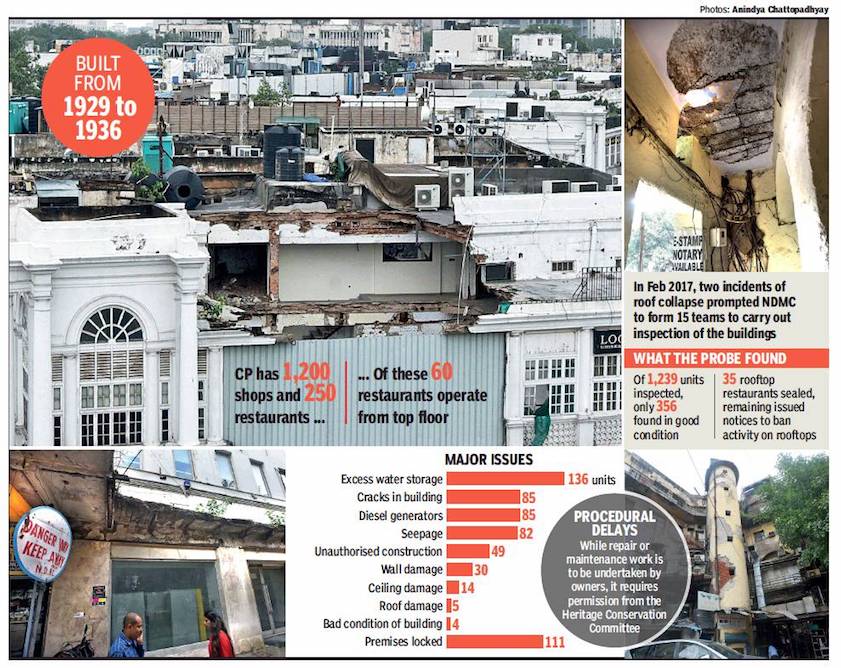
From: Mayank Manohar, Stumbling blocks: How red tape is killing CP, October 1, 2018: The Times of India
Traders Say Heritage Nod Must For Repairs But Takes Forever
Connaught Place is looking shaky at 90. Alarm bells rang when parts of two buildings tumbled down a week apart, in February 2017, but 20 months later, neither the shop owners nor the city’s heritage and civic bodies have done anything to preserve this iconic market.
Despite the costly renovation of the facade finished five years ago, the buildings are in such a bad shape that an in-house survey by New Delhi Municipal Council (NDMC) found only 356 of 1,239 in “good condition”.
More than their age, abuse and long neglect have weakened the buildings rapidly. NDMC’s inspection report mentions issues like seepage, cracks in walls, heavy load on the terrace, illegal construction, damaged roofs and ceilings, etc. In the backlanes, wires and pipes jut into view everywhere. In some places, trees have taken root inside cracks in the walls.
Ironically, rules meant to safeguard the market’s heritage character have become a hurdle for its upkeep. No heritage building can be repaired or renovated without the permission of the city’s Heritage Conservation Committee (HCC), but shop owners say the HCC sits on their proposals indefinitely.
“Many owners have applied to the HCC but not got permission, while their buildings are deteriorating by the day,” said Ruchin Garg, a shop owner. TOI could not get the HCC to respond to this allegation.
Garg said NDMC is also responsible for the deterioration as it has not acted against establishments placing heavy loads on buildings. “After the roof collapse, we wrote several letters to NDMC to take action against the increasing load on rooftops, but they did hardly anything.”
When he filed an RTI to know why NDMC had not repaired the two damaged buildings in C and L blocks, he was told it was the owners’ responsibility. But owners cannot do anything without the HCC’s permission, which is hard to get.
Atul Bhargava, president of New Delhi Traders’ Association, said if NDMC cannot repair the buildings, it should at least help them get the HCC’s permission. “It is difficult for the owners to get permission on their own, and many have stopped trying due to the HCC’s lethargic response.”
For the shop owners, going by the book is not only slow but also expensive. For example, a proposal for repairs can only be made by a consultant architect registered with NDMC. “If owners follow the rules, even minor repairs will cost at least Rs 5-6 lakh, and take at least 6-8 months,” said a source. But submitting a proposal does not guarantee approval, and the fee paid to the architect could go waste.
Bhargava said NDMC has not responded to their requests for mediating with the HCC. Because maintaining buildings legally is costly and complicated, owners are learnt to be carrying out repairs and modifications on the quiet.
NDMC, however, says it has done its job by banning all rooftop activity in Connaught Place. It had found 25-odd establishments using the roof commercially.
“We are also in the process of removing heavy materials from the terrace,” an NDMC official said. “We are also planning to replace generators with an automated power switchover, which will work as a high-capacity inverter. We tested it in a few blocks and the response was good.” He said all the generators will be removed from rooftops once the switchover facility is extended across the market.
As for repairs and renovation, the owners will have to pursue the HCC on their own, the official said. “Owners are authorised to carry out repairs and renovation as the building is leased out to them, and it is their job to get the work done.”
NDMC last proposed to redevelop Connaught Place in 2006. However, the Rs 615-crore project was delayed, and last year, Comptroller and Auditor General of India pointed out many deficiencies in the work.
The civic body had aimed to redevelop the market with better subways, roads, parking, free-flowing traffic, etc, while conserving its heritage character and the structural stability of its buildings. The CAG report said these goals “could not be achieved”.
Mahatta
The Times of India, Jul 05 2015
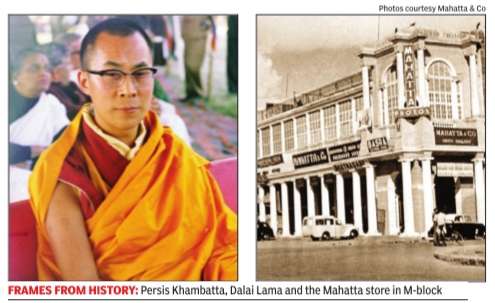
Avijit Ghosh
Unbeaten at 100, Mahatta a CP landmark
For old timers, Connaught Place is a graveyard of memories. Most shops and hang-outs, the bookmarks of their youth, are gone with the wind. To that generation, Mahatta & Co is a reassuring marker that some things endure.The fourth-generation family of photographers--since 1915, the sign outside the M-block shop declares--is now part of the city's living heritage. Mahatta & Co was first set up in the swish Bund area in Srinagar exactly 100 years ago. They even got the store's name there. The British tourists who thronged the shop mispronounced their surname, Mehta. However, the studio in Delhi, set up the year after the Partition, is their calling card.
Back in the 1970s and earlier, the photographic shop was regarded as the city's reliable matchmakers. In times when would-be grooms searched for a suitable bride from a bunch of snapshots, parents thronged the studio with requests to make their daughter look like a heroine, if possible even better. “The buzz was: just get your girl photographed from Mahatta. Uski shaadi ho jayegi,“ says Pavan Mehta, who now runs the shop with his brother Pankaj.
Times have changed but weddings continue to play an important part in their profile. Now Pavan's son, Arjun, a fourth generation Mehta, shoots for wedding albums in places even as far as Bangkok.
The Mehtas discovered the world of photography by chance. Pavan's grandfather Amar Nath, only 14 then, fled his haveli in Punjab's Gurdaspur district to escape a bloody family feud in 1912. He landed in Dalhousie, where he learnt the art of photography on a Rolliflex camera and technique of developing film the from foreign tourists. m foreign tourists.Family reasons made him shift to Srinagar with their studio lo cated for some time cated for some time in a houseboat. Over the next few decades, Mahatta & Co be came a well known brand opening stores as F far as Rawalpindi and Sialkot. During the chaos of Partition, the Mehtas shifted to Delhi. At CP, they functioned initially from the pavement outside Embassy restaurant; their lab at the Palace Heights hotel nearby . They moved to the M-block store in 1948.
Their early customers were mostly the city's elite: royalties, army , gen try with impressive appendages to their names: sir, rai bahadur etc. Watching their old photographs, many of them lensed by Pavan's father Madan, is like taking a guided tour of evolving India. Of black and white days when you could hear the hoofs of tongas in uncluttered CP, when Nehru-Indira holidayed in Kashmir, when Pragati Maidan's geometrical interiors was taking shape.
An incident from his early youth ncident from his early youth is embossed in Pavan's mind. First, when he taught Amitabh Bachchan the finer points of dark room techniques for 10 days. “He was recuperating from the life-threatening injury he had suffered during Coolie's (1983) shooting at a farmhouse in south Delhi.We were asked to teach him how to develop a film. One of the bathrooms was converted into a dark room for the job. Bachchan saab was a keen learner,“ recalls Pavan.
Today the Mehtas have a studio bursting with old cameras, a room stuffed with negatives and a head full of history . They are participant as well as witness to the changes in the profession. Pavan remembers the 1970s when the shop was so much in demand that delivery of prints took a week; now it's an hour. Everything changed once the world went digital.Some things, though, have remained the same. Wedding photography continues to be their primary breadwinner. “At the peak of the season, there's plenty of work.We do assignments in Bangalore, Goa, Mumbai,“ he says.
Generally speaking, these are hard times for old studios in CP and around. In recent years, several studios of repute-Kinsey Brothers, Rangoon Studio, Shimla Studio, Delhi Photo Company--have downed the shutters. Pavan and his family are survivors amidst the carnage. “To mark our centenary , we are working on a book which should hopefully be released on August 19, world photography day ,“ he says.
On their aging shoulders, Mahatta & Co continue to carry the burden of history and heritage.
Madame Tussauds
2017: inauguration
Paras Singh, Wait’s over: Tussauds finally comes to town, December 1, 2017: The Times of India
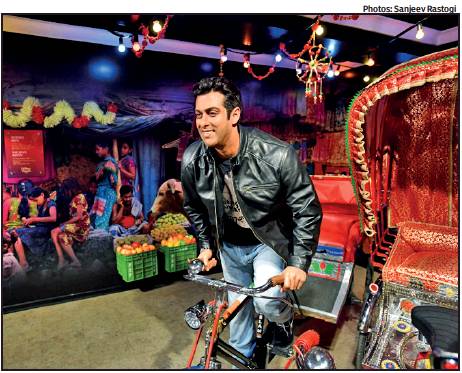
From: Paras Singh, Wait’s over: Tussauds finally comes to town, December 1, 2017: The Times of India
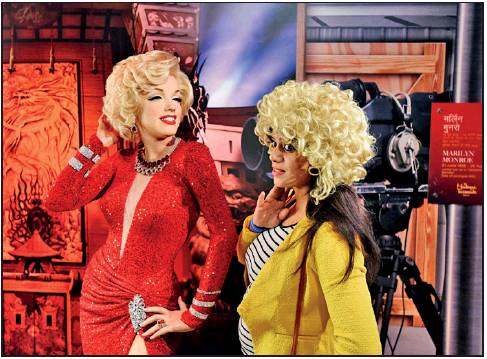
From: Paras Singh, Wait’s over: Tussauds finally comes to town, December 1, 2017: The Times of India
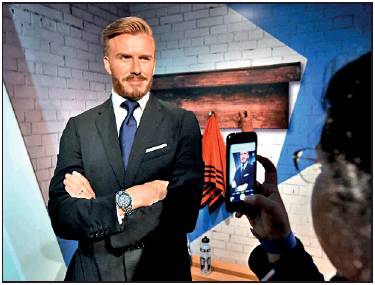
From: Paras Singh, Wait’s over: Tussauds finally comes to town, December 1, 2017: The Times of India
Insulated from the modern hurry of Connaught Place, past a narrow staircase ascending to the first floor the heritage Regal Cinema building lies a frozen world. At the entrance you encounter Bajrangi Bhaijaan on arickshaw, and the sight of actor Salman Khan at such close quarters makes you thankful that Delhi, from Friday, is the 23rd centre for the global attraction, Madame Tussauds.
Inside, selfie opportunities abound among the 50 obliging personalities standing still in four sections: host city, Indian history, sports and music and “A lister party”. And no, there are no stern notices frowning at touchy-feely tendencies. In fact, visitors are encouraged to be tactile in their interaction with the wax statues. Which means you get to ride a snazzy Ducati with Tom Cruise, be a member of the audience laughing at Kapil Sharma’s gags or sit in the hot seat with as Anil Kapoor asks you if you want to be a millionaire.
What is more, interactive games and hidden tricks incorporated into the statues’ surroundings augment the waxen reality: stand atop the podium with the trophy and you hear the crowd applauding or try to sneak into Ranbir Kapoor’s changing room and you will have an old man shouting at you.
A more sober experience is your meeting with Mahatma Gandhi, Bhagat Singh, Vallabhbhai Patel and Netaji Subhas Bose and you race past the years to run into PM Narendra Modi and former president APJ Abdul Kalam. From national pride to pop culture is an easy enough transition, with singers Sonu Nigam, Asha Bhonsle and table maestro Zakir Hussain beckoning you towards pop icons Justin Beiber, Madonna and Lady Gaga.
For an experience of this sort, you have to fork out Rs 960 if you are an adult and Rs 760 for children. Madame Tussauds will be open on all seven days, enticing you to gleefully rub shoulders — literally — with A listers from Hollywood and Bollywood, including Madhuri Dixit, Katrina Kaif, Will Smith, Scarlett Johannson and Angelina Jolie. Mary Kom can be caught as she swings at her opponent, Milkha Singh is in mid-run and Kapil Dev frozen at the moment of releasing a hurricane delivery, but footballers like Cristiano Ronaldo, Lionel Messi and David Beckham remain the prime attractions in the sports section.
“Since we are allowing people to touch the statues and interact with them, some wear and tear will obviously take place, but we have a dedicated team based in Delhi to ensure good upkeep of the statues that have all been crafted in London,” said Anshul Jain, director of Merlin Entertainments India, the tour organiser.
The museum plans to add 15 new statues every year. “We will let the visitors decide that. Delhiites should decide who they want to see,” said Marcel Kloos, director for the museum in the emerging markets.